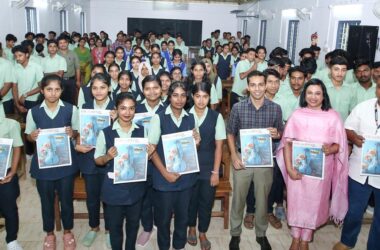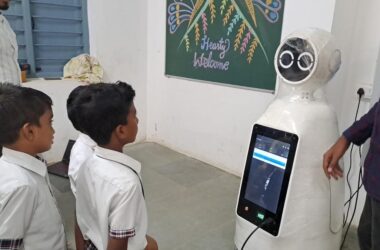Susmita Mohanty wears many hats: spaceship designer, serial entrepreneur, and area diplomat. She is co-founder and director-general of Spaceport SARABHAI (S2), India’s first space-focused think-tank, which she based in 2021. Ms. Mohanty has spent greater than 25 years within the worldwide area sector working with the Individuals, Europeans, Japanese, Russians, and Indians in varied capacities, and is invested in India’s transformation right into a developed area financial system, gender parity within the area ecosystem, and area sustainability. Throughout an interview in her house in Bengaluru, she spoke to The Hindu about her disappointment with ladies being excluded from the method of selecting astronauts for the Gaganyaan’s first crewed mission, India’s place amongst spacefaring nations, and what our fledgling area spart-ups have to thrive. Edited excerpts comply with.
Having extra ladies in area, particularly in management roles, appears necessary to you. You latterly wrote about how no lady was eligible to be thought-about for Gaganyaan’s debut flight because the candidates had been required to be fight pilots of teacher grade, which dominated out ladies candidates.
My response to the all-male Gaganyaan astronaut choice was pure since I grew up in an India the place ladies have at all times been a part of the ISRO [Indian Space Research Organisation] workforce and have taken to science and engineering fairly fortunately. ISRO has a great gender steadiness. In the event you speak to ladies scientists in ISRO, they are going to let you know they take pleasure in working there. Apart from, India has the very best variety of ladies pilots on the planet. As an alternative of celebrating that and letting them compete, we’re simply closing the gate on them. It doesn’t make sense.
Because of advances in area applied sciences, flying to area is now accessible to unusual residents who haven’t been a part of a navy setting, which is why you have got area vacationers. Even when the [Gaganyaan] choice committee needed to restrict the primary spherical to IAF pilots, they might simply have allowed the ladies IAF pilots to compete.
We now have greater than 100 ladies non-combat (helicopter, transport) pilots as a result of we began accepting ladies within the IAF [Indian Air Force] 30 years in the past, in 1993. A retired IAF pal advised me that we now have 19 ladies fight pilots since we began inducting them in 2016. Not permitting our ladies pilots to compete was an enormous missed alternative for India.
I want I didn’t have to write down these articles within the first place. We now have ladies who’re certified, succesful, and raring to go. So why shut the gate on them? Cease being gatekeepers, let there be truthful play.
Are you able to discuss your childhood in Ahmedabad, and the way it formed your creativeness about area?
I used to be raised in what I name Sarabhai-and-Gandhi Ahmedabad, [which is] quite completely different from its up to date avatar. My college principal was a Gandhian. Native industrial households had been engaged in cultural philanthropy and establishment constructing and promoted internationalism.
Among the many many nice establishments that nurtured my curiosity, creativity, and renaissance-upbringing had been the Faculty of Structure (CEPT), Kanoria Arts Centre, Nationwide Institute of Design, Area Purposes Centre, Bodily Analysis Laboratory, Centre for Surroundings Training, Textile Analysis Affiliation, and the Indian Institute of Administration.
In my years since, I’ve lived in a number of cities within the U.S. and Europe. I’ve travelled the globe. By no means have I come throughout a metropolis that has so many institutes of excellence in such a small radius. Raised in a milieu of area pioneers and famend up to date architects, I used to be smitten with the concept of area structure and design.
I used to be a hyper-motivated child. Whereas in high-school, armed with a bicycle, my dad’s transportable German typewriter, and entry to wonderful libraries, I began engaged on design issues of dwelling and dealing in microgravity. Again then there was no web. So I’d use Indian submit to mail design concepts to NASA, the European Area Company (ESA), and American universities. Some even responded on occasion. That saved me going.
The place does India stand immediately amongst spacefaring nations? What’s the Indian area financial system like in comparison with different nations, and the nation’s potential in area analysis and exploration?
India has one of many oldest area applications on the planet. We did our first sounding rocket launch in November 1963. Attending to a profitable Moon touchdown has taken 60 years of onerous work and perseverance with many milestones alongside the way in which. We launched our first satellite tv for pc, Aryabhata, in 1975; had our first profitable PSLV launch in 1993; and our first profitable GSLV launch in 2001. We launched our first Moon mission in 2008 and Mars mission in 2013.
As an impartial younger nation, as we began to slowly recuperate from greater than 200 years of colonial plundering, India’s first Prime Minister Jawaharlal Nehru had the foresight to commit a considerable chunk of our meagre funds to science and know-how early on. That basis is key to who and the place we’re immediately, as a nation. Any nation with a complicated area programme corresponding to ours takes a great half a century to get there. Area know-how is complicated.
At worldwide area discussion board, once I hear anybody confer with India as an ‘rising area nation’, I flinch. I at all times insist on setting the document straight. The extent of ignorance, even conceitedness is commonly staggering. The outdated area narrative has a robust Western bias as a result of it was largely formed by the Chilly Struggle and Hollywood movies.
India ranks among the many prime six space-faring nations by way of area capabilities, the others being the U.S., Russia, China, Japan, and France. In the event you rely Moon landings, then France may be dropped from the record. Quickly India will change into one in all 4 nations to have impartial human spaceflight functionality as soon as we launch people into low-earth orbit.
A few of us are engaged on crafting a brand new Twenty first-century area narrative to replicate the [space] energy shift to the jap hemisphere, with China, India and Japan main the way in which.
In 2007, once I determined to go away San Francisco and transfer again to India, I wrote to my mentor Arthur Clarke about my determination. He wrote again saying, “That may be very strategic.” After I requested him why he thought so, he wrote again saying, “All the things started within the East and goes again there.” He cited the instance of Chinese language alchemists having invented gunpowder and mentioned, “No gunpowder, no rockets.”
As somebody keen about preserving the setting, each our personal and in outer area, are you able to speak concerning the affect of area particles?
I fear concerning the Moon as a result of it’s again within the cross-hair of human exploration. The Moon’s pristine setting will most certainly be impacted adversely by human greed and the necessity to monetise every part. Area companies and personal corporations is not going to cease at exploration and can seemingly resort to [mass] extraction of sources. Some nations such because the U.S. and Luxembourg have unilaterally handed legal guidelines that can permit their non-public corporations to extract and personal area sources. The prospect of area mining is actual.
That’s not all. People are good at littering – there’s proof on earth and in low-earth orbit.
We now have made low-earth orbit a harmful place due to tonnes of particles generated as a consequence of human actions. Particles objects may be as small as a chip of paint or as massive as a defunct satellite tv for pc or a discarded photo voltaic panel. Particles statistics on the ESA’s web site point out we now have round 36,000 objects bigger than 10 cm, 1 million objects between 1 cm and 10 cm, and 130 million objects between 1 mm and 1 cm. Orbiting particles strikes at 28,000 km/hour, so it packs a punch.
Some area particles burns up because it re-enters the environment, some fall into the ocean, and a few onto land. Not all particles re-entries are managed. For instance, NASA had jettisoned a big pallet of outdated batteries weighing roughly 2.6 tonnes from the orbiting Worldwide Area Station [ISS], intending for them to expend on re-entry. A fraction survived the journey and crashed right into a Florida house in March this yr.
There are Inter-Company Area Particles Coordination Committee [IADC] tips for post-mission disposal of area {hardware}, however not everybody follows these procedures
How can area play a job in monitoring the consequences of the local weather disaster?
Earth remark (EO) satellites don’t simply assist us monitor world warming and ice melts, additionally they assist sort out the impacts of local weather change. For instance, my former firm Earth2Orbit’s EO analytics enterprise arm had developed fashions that used satellite tv for pc imagery and advances in machine-learning analytics to be used instances that might make cities ‘local weather sensible’, for instance monitor air pollution, warmth islands, city sprawl, underground water.
Additional, area know-how spin-offs and satellite tv for pc companies have purposes that may profit the setting. Satellite tv for pc-based techniques may be leveraged to assist cut back automobile emissions, make wind generators extra environment friendly, and assist photo voltaic cells produce extra vitality.
Most purposes use a cocktail of satellites for telecom, distant sensing, meteorology, and navigation. Corporations concerned in downstream purposes are innovating and creating new companies and merchandise to mitigate local weather change and to assist individuals, for instance farmers and fisher people, address local weather change.
I’d like to speak about your journey as an area entrepreneur, and the three start-ups you’ve based on three continents: MOONFRONT in San Francisco, LIQUIFER in Vienna, and EARTH2ORBIT (E2O) in India. Why did you select to go the entrepreneurial route?
I started my skilled area journey in 1997 with a quick stint at NASA’s Johnson Area Centre. After that, I labored for the ISS programne at Boeing in southern California for nearly three years. This gave me an in-depth understanding of how the area trade works.
In 2000, I left Boeing, moved to San Francisco, and began a boutique area consulting agency known as MOONFRONT. I made a decision to change into an entrepreneur as a result of if you work for an area company or a big firm, you can’t converse your thoughts freely. You need to toe the road, roughly. I’m the kind who likes to ask questions and problem the established order.
4 years after MOONFRONT, I co-founded an area structure and design agency known as LIQUIFER with a pal in Vienna. LIQUIFER Techniques Group, as it’s now known as, not solely designs area exploration, habitation, and transportation techniques but additionally makes full-scale prototypes and exams them in analogue environments.
In 2008, I moved again to India and began my third enterprise, EARTH2OBIT (E2O). E2O performed a pivotal position in opening up the U.S. launch marketplace for the ISRO’s PSLV rocket. We additionally developed EO analytics merchandise for crop forecasting and making cities climate-smart.
In 2021, I co-founded India’s first devoted area suppose tank. We offer research-based coverage steering to the federal government, give India a world voice, and push for reforms that may assist India change into a developed area financial system.
There was loads of dialog across the privatisation of area in India. We’re privatising area launches and are within the technique of permitting FDI within the manufacture of satellites. Your ideas?
Privatising routine satellite tv for pc and rocket meeting for mature applied sciences might have began 20 years in the past. I’m advised there was reluctance and pushback from the federal government area company. The concern of shedding management was palpable. The truth that it’s lastly occurring is sweet information. Not simply privatisation however even commercialisation of ISRO-tech has began to get traction.
Broadly talking, there are three sorts of area corporations in India at present: the NewSpace start-ups, legacy corporations massive and small which were catering to ISRO’s wants for a number of many years, and telecom corporations corresponding to Jio Satcom and the Bharti Group-backed OneWeb.
The area reforms introduced by the Indian authorities in 2020 mark the start of a brand new section in India’s area journey. Operationalising these reforms will take time, however it’s a transfer in the precise course. There’s now an area regulator known as IN-SPACe that’s the one-stop interface for area corporations looking for licenses, entry to environmental take a look at services, and different types of cooperation to get their companies rolling.
What’s lacking is funding on the size you discover in developed area economies such because the U.S. SpaceX, for instance, wouldn’t exist with out the billions of taxpayer funds it will get from NASA and the DoD [Department of Defense]. An American EO satellite tv for pc firm’s largest buyer is normally the U.S. Division of Agriculture and the Nationwide Reconnaissance Workplace. Equally, our authorities must change into an ‘anchor buyer’ for our corporations for them to scale and thrive. The federal government can’t count on our corporations to run on non-public capital.
In 2023, IN-SPACe’s ‘Decadal Imaginative and prescient and Technique for the Improvement of the Indian Area Economic system’ claimed it is going to propel India’s fledgling area trade from $8.2 billion at present to $44 billion by 2033. The fact is sort of humbling. In 2023, cumulatively our [250 or so] area start-ups raised a meagre $134 million.
This February, the federal government introduced FDI [foreign direct investment] liberalisation for the area sector. The FDI cash will are available solely when we now have absolute regulatory readability, a considerably developed area insurance coverage panorama, and higher safety of mental property. We additionally want nationwide area laws, which is but to occur. So there’s a lengthy method to go. We’re simply getting began.







